Laboratory
 Here you see a CDC laboratory researcher
at work. This laboratory combines elements found in CDCs infectious
disease and environmental health laboratories. Because CDC
researchers work with some
of the most deadly organisms and substances in the world,
safety is top priority. See how many safety devices you can
find in
and around the laboratory. Be sure to notice the interesting
items on the bulletin board in the corridor.
Here you see a CDC laboratory researcher
at work. This laboratory combines elements found in CDCs infectious
disease and environmental health laboratories. Because CDC
researchers work with some
of the most deadly organisms and substances in the world,
safety is top priority. See how many safety devices you can
find in
and around the laboratory. Be sure to notice the interesting
items on the bulletin board in the corridor.
 Here is the 'Biological Hazard Safety' Book. That squiggly
design on the cover is the International symbol for biological
hazardous material. It's important because it tells you how
to stay safe in a biological hazard lab. Everyone at CDC who
works in a lab has to memorize this book. It may not be too
much fun to read, but it could be worse. At least it has diagrams
in it.
Here is the 'Biological Hazard Safety' Book. That squiggly
design on the cover is the International symbol for biological
hazardous material. It's important because it tells you how
to stay safe in a biological hazard lab. Everyone at CDC who
works in a lab has to memorize this book. It may not be too
much fun to read, but it could be worse. At least it has diagrams
in it.
Want to read it for yourself? Click here
Sharps Container
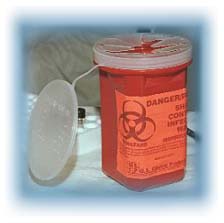 No this isn't a thermos or a cup. It's called a sharps container
and this is where Eloise puts her contaminated sharp items
like needles, scalpels and glass slides to name a few, after
she's finished working with them. She's very careful and doesn't
want anyone to get cut.
No this isn't a thermos or a cup. It's called a sharps container
and this is where Eloise puts her contaminated sharp items
like needles, scalpels and glass slides to name a few, after
she's finished working with them. She's very careful and doesn't
want anyone to get cut.
Good for her.
Radioactive Storage Box
 As you can 'clearly' see by the labels on it, this box is
used for holding radioactive materials. But only temporarily,
because they'll be thrown out later in a designated, safe receptacle,
of course.
As you can 'clearly' see by the labels on it, this box is
used for holding radioactive materials. But only temporarily,
because they'll be thrown out later in a designated, safe receptacle,
of course.
Geiger Counter
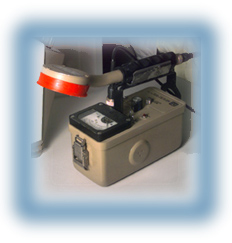 Now you may wonder how many Geigers can a Geiger counter count?
I don't know that, but I do know it lets you know if something
is radioactive by making a clicking sound. The higher the radiation,
the faster the clicks. Speaking of clicks, click some more
to find other safety devices in the lab.
Now you may wonder how many Geigers can a Geiger counter count?
I don't know that, but I do know it lets you know if something
is radioactive by making a clicking sound. The higher the radiation,
the faster the clicks. Speaking of clicks, click some more
to find other safety devices in the lab.
Chemical Fume Hood
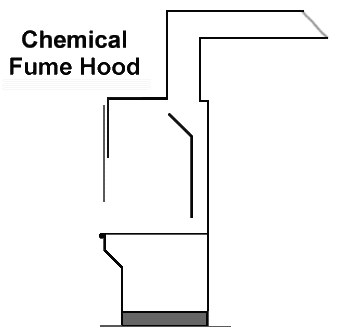 This is called a chemical fume hood and it protects Eloise
from dangerous fumes. How does it work? Watch the cool animation
as the good air is "sucked" in and the bad air is "pushed" out
the top. Almost like breathing, huh?
This is called a chemical fume hood and it protects Eloise
from dangerous fumes. How does it work? Watch the cool animation
as the good air is "sucked" in and the bad air is "pushed" out
the top. Almost like breathing, huh?
Face Shield & Lab Coat
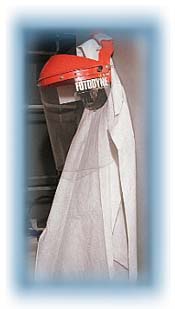 No, this isn't rain gear. The face shield and extra lab coat
protect Eloise's skin from contamination. And though as fashionable
as they may look, she never wears them outside the lab. Why
not? She doesn't want to take her work home with her (or anywhere
else)!
No, this isn't rain gear. The face shield and extra lab coat
protect Eloise's skin from contamination. And though as fashionable
as they may look, she never wears them outside the lab. Why
not? She doesn't want to take her work home with her (or anywhere
else)!
Rubber Gloves
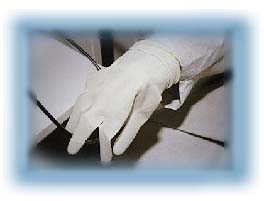 Before Eloise begins working in the lab, she takes off her
jewelry, and then puts on a pair of rubber gloves. Not only
do the gloves protect her hands from contamination, they also
keep her hands nice and smooth.
Before Eloise begins working in the lab, she takes off her
jewelry, and then puts on a pair of rubber gloves. Not only
do the gloves protect her hands from contamination, they also
keep her hands nice and smooth.
Eye Wash Station
 I know we wash our hair, but wash our eyes? That's what we
would have to do, if we got any chemicals in them. How does
it work? Well, when you turn the handles on the eye washer,
the little green cups fly off to the sides, because of the
water pressure. Then you put your eyes over the 2 faucets so
it can rinse them out. This is why it's important to wear safety
goggles...no matter what color they are.
I know we wash our hair, but wash our eyes? That's what we
would have to do, if we got any chemicals in them. How does
it work? Well, when you turn the handles on the eye washer,
the little green cups fly off to the sides, because of the
water pressure. Then you put your eyes over the 2 faucets so
it can rinse them out. This is why it's important to wear safety
goggles...no matter what color they are.
Lab Coat, Safety Goggles
& Dosimeter Badge
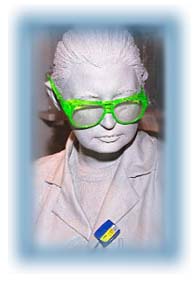 Eloise doesn't have to worry about what to wear to work every
day because she always wears her lab coat, a dosimeter badge,
which detects how much radiation she's exposed to, and look
at those wild safety goggles. Who said you can't be cool and
safe at the same time?
Eloise doesn't have to worry about what to wear to work every
day because she always wears her lab coat, a dosimeter badge,
which detects how much radiation she's exposed to, and look
at those wild safety goggles. Who said you can't be cool and
safe at the same time?
